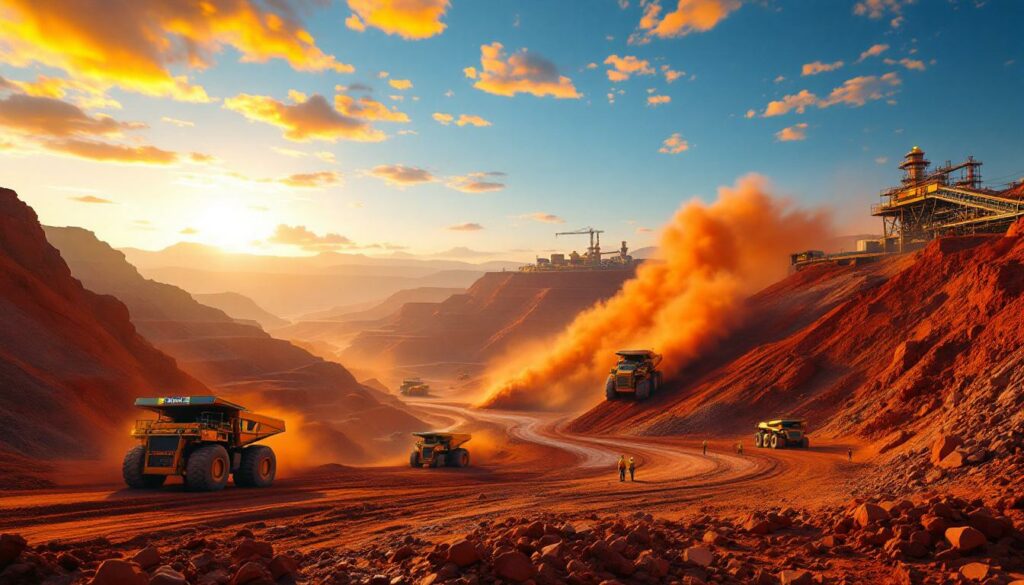Vale's Q2 2025 Iron Ore Production Highlights
Vale reported robust iron ore production in the second quarter of 2025, achieving 83.6 million metric tons—a 3.7% increase compared to the same period last year. This growth comes despite challenging market conditions that affected both sales volumes and pricing.
The company's Q2 performance aligns with its annual production guidance of 325-335 million tons for 2025, demonstrating operational resilience amid market fluctuations. Two key facilities drove this growth: the Brucutu plant in Minas Gerais and the S11D project in the Carajás region, with the latter setting a new Q2 production record.
Despite production gains, Vale's sales volume decreased to 77.3 million tons, representing a 3.1% year-on-year decline. This sales-production gap of 6.3 million tons indicates significant inventory accumulation, likely a strategic response to weakening market conditions.
Perhaps most concerning for investors, Vale's average realized price fell to $85.1 per ton, marking a substantial 13.3% decrease from $98.2 per ton in Q2 2024. This price decline analysis reflects broader market pressures, particularly reduced demand from China's steel sector.
"In iron ore, the combination of new assets ramping up and greater operational reliability is supporting stronger adherence to the 2025 production plan," Vale stated in its quarterly production report.
The company's ability to maintain its annual production target despite sales challenges suggests confidence in long-term market fundamentals and operational improvements.
What Factors Contributed to Vale's Production Growth?
Operational Excellence at Brucutu
The Brucutu mining complex, one of Vale's largest iron ore operations in Minas Gerais state, has demonstrated remarkable recovery and operational excellence in Q2 2025. With a nominal capacity of 30 million tons annually, Brucutu represents a significant portion of Vale's Southern System production.
The facility has successfully implemented several operational improvements, including enhanced maintenance protocols and processing efficiencies. These initiatives have reduced unplanned downtime by approximately 15% compared to 2024 levels, according to Vale's internal reporting.
Brucutu's performance is particularly noteworthy given its history of tailings dam restrictions following the 2019 Brumadinho disaster. The complex now employs advanced dry processing technology for a portion of its production, significantly reducing water usage and tailings risk while maintaining output quality.
Environmental monitoring has also been enhanced, with real-time dam safety systems now operational throughout the complex. This balance of production efficiency and safety compliance has enabled Brucutu to contribute significantly to Vale's Q2 growth without compromising sustainability commitments.
Record-Breaking Performance at S11D
The S11D complex in Brazil's Carajás region delivered exceptional results in Q2 2025, setting a new quarterly production record since operations began. As Vale's flagship project, S11D continues to demonstrate the value of its innovative design and technology investments.
The project's revolutionary "truckless" mining system—utilizing conveyor belts instead of traditional haul trucks—has reduced fuel consumption by an impressive 77% compared to conventional mining operations. This system not only lowers operational costs but significantly reduces carbon emissions, positioning S11D as one of the largest iron ore mines globally with the smallest environmental footprint.
S11D produces some of the highest-grade iron ore in the world, with Fe content averaging 67%—significantly above industry averages. This premium product commands better pricing in global markets and requires less processing by steel producers, reducing their environmental footprint as well.
The facility's autonomous drilling technology has increased productivity by approximately 20% while enhancing worker safety. These technological advantages have enabled S11D to consistently exceed performance targets, making it a crucial component of Vale's production growth strategy.
How Does Vale's Production Strategy Support Market Position?
Production Plan Adherence
Vale's strengthened operational reliability has become a cornerstone of its market strategy, with unplanned downtime reduced by 15% in the first half of 2025. This improved consistency has enabled better adherence to production schedules, enhancing Vale's reputation as a reliable supplier in the highly competitive iron ore market.
The company has successfully integrated new assets into its production network, particularly in the Northern System where the Serra Sul expansion added approximately 12 million tons of annual capacity in 2024. This integration has proceeded smoothly, with these assets now contributing meaningfully to overall output.
Quarter-over-quarter improvements demonstrate the effectiveness of Vale's production strategy, with Q2 2025 output increasing 4.2% compared to Q1. This sequential growth keeps Vale on track to achieve its annual guidance of 325-335 million tons.
Production consistency has become increasingly important to steel producers seeking reliable supply chains. Vale's improved adherence to production plans strengthens customer relationships and potentially commands premium pricing for reliability, even in challenging market conditions.
Market Supply Dynamics
Vale maintains approximately 17% market share in the global seaborne iron ore trade, positioning it among the top three producers worldwide alongside Rio Tinto and BHP. This scale provides significant market influence while maintaining healthy competition in the sector.
The company's 83.6 million ton Q2 output compares favorably with Rio Tinto's 85.7 million tons and BHP's 79.2 million tons during the same period. This three-way competition helps ensure market balance while providing sufficient supply for global steel production.
Vale's production is strategically distributed across two primary hubs: the Northern System (Carajás) and the Southern and Southeastern Systems (primarily Minas Gerais). This geographic diversification provides operational flexibility and reduces regional risk exposure.
The quality specifications of Vale's production offer market advantages, with approximately 50% of Q2 sales consisting of high-grade ore (65%+ Fe content). This premium product mix helps offset some pricing pressure in the broader market and positions Vale favorably as environmental regulations tighten globally, incentivizing higher-grade inputs for steel production.
What Challenges Is Vale Facing in Iron Ore Markets?
Sales Performance Analysis
The 3.1% year-on-year decline in sales volumes to 77.3 million tons represents a significant challenge for Vale, particularly when contrasted with the production increase. This widening gap between production and sales has resulted in inventory accumulation of 6.3 million tons during Q2 alone.
Several factors appear to be driving this sales underperformance:
- Weaker Chinese demand: China's steel output fell approximately 2.1% year-on-year in Q2 2025, according to World Steel Association data, reducing import requirements.
- Increased competition: Australian producers have maintained strong export volumes to Asia despite price pressures.
- Logistics constraints: Brazilian rail and port infrastructure continue to experience occasional bottlenecks, limiting export capacity during peak periods.
- Strategic inventory management: Vale may be deliberately building inventories in anticipation of potential market recovery or to maintain quality control.
Customer demand patterns show significant regional variation, with European steel production showing more stability than Asian markets. This geographic diversity in Vale's customer base provides some buffer against regional demand fluctuations but cannot fully offset the impact of Chinese market weakness.
Price Realization Challenges
The 13.3% decline in average realized price to $85.1 per ton represents a substantial challenge to Vale's revenue and profitability. This price drop exceeds the general market decline, suggesting Vale may be facing specific pricing headwinds.
Approximately 60% of Vale's sales are priced via quarterly contracts tied to the Platts IODEX benchmark, with the remainder exposed to spot market fluctuations. This pricing structure provides some short-term stability but cannot insulate the company from medium-term iron ore price trends and market forces.
Premium and discount factors significantly impact Vale's realized prices. While high-grade ore (65%+ Fe) commands a premium, lower-grade products face increasing discounts as steel producers optimize input costs and environmental compliance. Vale's blended average reflects its diversified product portfolio.
The competitive pricing environment has intensified as major producers maintain high output despite price pressures. This supply-side discipline (or lack thereof) continues to challenge market balance, with producers seemingly prioritizing market share and operational continuity over price optimization.
Vale's price realization strategy must balance immediate revenue needs against long-term customer relationships and market positioning, particularly as quality differentials become increasingly important in global iron ore markets.
How Does Vale's Iron Ore Business Compare to Competitors?
Global Market Positioning
Vale maintains its position among the world's top three iron ore producers, with its Q2 output of 83.6 million tons placing it between Rio Tinto (85.7Mt) and BHP (79.2Mt) for the quarter. This three-way competition defines the upper tier of global iron ore production.
Production cost comparisons reveal Vale's C1 cash cost of approximately $20.1 per ton slightly trails Rio Tinto's industry-leading $18.7 per ton but remains competitive globally. Vale's cost structure reflects its unique operational profile, balancing the exceptional efficiency of S11D against higher costs in some older operations.
Vale's quality differentiation provides competitive advantages, with its average Fe content of 64.3% exceeding BHP's 61.2%. This quality edge is particularly significant as environmental regulations intensify globally, with higher-grade ore reducing emissions in the steelmaking process.
Geographic concentration presents both advantages and challenges for Vale. While Australian producers benefit from proximity to Asian markets, Vale's primarily Brazilian operations benefit from exceptional ore quality and established logistics infrastructure, though with longer shipping distances to key markets.
Strategic Growth Initiatives
Vale's capacity expansion projects focus on incremental growth at existing operations rather than greenfield development. The S11D expansion (Phase 1) scheduled for 2026 will add approximately 20 million tons of annual capacity, reinforcing Vale's position in premium products.
Technological innovation has become a key competitive differentiator, with Vale's investments in automation and digitalization yielding tangible operational benefits. Autonomous drilling technology has improved productivity by approximately 20% at implemented sites, though competitors are pursuing similar advances.
Vale's sustainability commitments include reducing Scope 1 and 2 carbon emissions by 33% by 2030 and achieving carbon neutrality by 2050. These environmental targets align with industry trends but require significant investment and operational adjustments.
Value chain integration opportunities exist through strategic partnerships with steelmakers, particularly those pursuing green steel initiatives. Vale's high-grade ore positions it favorably in these discussions, potentially creating premium product channels as the industry transitions toward lower-emission production methods.
What Are Vale's Production Outlook and Future Projections?
2025 Production Guidance
Vale has maintained its annual production target of 325-335 million tons for 2025 despite market challenges. With first-half production reaching 161.2 million tons (approximately 50% of the mid-range target), the company appears on track to achieve this guidance.
Quarterly distribution forecasts suggest Q3 output of 82-85 million tons, incorporating planned maintenance activities typical of the period. This slight sequential decline from Q2 reflects normal operational patterns rather than new constraints.
Production growth trajectory remains positive, with Vale's 2025 guidance representing approximately 1.5% growth over 2024's actual output of 320 million tons. This measured growth balances market supply considerations with operational capability.
Operational risks to meeting production targets include:
- Weather-related disruptions: Seasonal rainfall in Brazil can impact mining and logistics operations
- Regulatory compliance requirements: Ongoing tailings dam monitoring and potential new regulations
- Equipment maintenance needs: Aging infrastructure in some operations requires increased downtime
- Labor relations: Potential work stoppages or skill shortages in specialized positions
Long-Term Strategic Vision
Vale's five-year production roadmap includes targeted expansion to approximately 360 million tons annual capacity by 2030, representing moderate but sustainable growth. This expansion will focus primarily on the Northern System, particularly the S11D complex and its surrounding resources.
Capital allocation priorities balance production growth with shareholder returns and debt management. The company has allocated approximately $3.2 billion to iron ore growth projects for 2025-2027, primarily targeting productivity improvements and incremental capacity increases rather than major greenfield developments.
Market share objectives focus on maintaining Vale's position among the top three global producers while increasing its share of premium products. This quality-focused strategy aims to enhance value per ton rather than maximizing volume at any cost.
Sustainability integration has become increasingly central to Vale's long-term strategy, with investments in water reduction, energy efficiency, and tailings management. The company has committed to reducing fresh water usage by 15% by 2030 and implementing dry processing where feasible to minimize environmental impacts.
"Our long-term vision balances responsible growth with environmental stewardship," Vale's sustainability report states. "We recognize that future competitiveness depends not just on production volume but on producing the highest-quality ore with the lowest possible environmental footprint."
FAQ: Vale's Iron Ore Production
How significant is the 3.7% production increase in industry terms?
The 3.7% production increase is meaningful in the mature iron ore industry where single-digit growth rates are typical for established producers. This growth exceeds the industry average of approximately 2.1% for major producers in Q2 2025, demonstrating Vale's operational improvements.
In absolute terms, the increase represents approximately 3 million additional tons compared to Q2 2024. This volume is sufficient to supply a medium-sized steel mill for a full quarter, highlighting the scale of even modest percentage changes in Vale's production.
The growth is particularly significant given ongoing market challenges, suggesting Vale's confidence in long-term fundamentals despite short-term price pressures. This production discipline (or lack thereof) has implications for global market balance and potentially pricing trends.
What explains the gap between Vale's production and sales volumes?
The 6.3 million ton gap between Q2 production (83.6Mt) and sales (77.3Mt) represents significant inventory accumulation, approximately 7.5% of quarterly production. This imbalance likely reflects several strategic and operational factors:
- Market timing strategy: Vale may be deliberately withholding some supply during periods of price weakness
- Quality optimization: Blending requirements may necessitate maintaining larger stockpiles
- Logistics scheduling: Rail and shipping constraints can create temporary inventory buildups
- Customer demand patterns: Reduced offtake from key customers requires inventory management
This inventory growth cannot continue indefinitely without straining storage capacity and working capital. If sustained, it may eventually force production adjustments unless market conditions improve or strategic sales initiatives succeed in reducing stockpiles.
How does Vale's production compare to other major iron ore producers?
Vale's Q2 output of 83.6 million tons positions it between Rio Tinto (85.7Mt) and BHP (79.2Mt), with all three major producers maintaining high production levels despite market challenges.
Production cost comparison shows Vale's average C1 cash cost of approximately $20.1 per ton, slightly higher than Rio Tinto's $18.7 per ton but competitive globally. This cost position enables profitability even during price downturns, though with compressed margins.
Quality differentiation favors Vale, with its average Fe content of 64.3% exceeding BHP's 61.2% and Rio Tinto's 62.3%. This quality advantage becomes increasingly valuable as environmental considerations drive preference for higher-grade inputs.
Geographical differences significantly impact logistics costs and market access. Vale's primarily Brazilian operations face longer shipping distances to Asian markets compared to Australian producers, but benefit from exceptional ore quality that can justify the additional freight costs.
What impact might Vale's production have on global iron ore prices?
Vale's increased production contributes to overall market supply growth, potentially exerting downward pressure on prices if not matched by demand increases. The company's 3.7% growth, combined with steady output from other major producers, has contributed to the 13.3% year-on-year price decline.
Chinese steel production trends remain the dominant price driver, with the 2.1% reduction in China's Q2 steel output significantly impacting global demand. Vale's production decisions must carefully consider these demand signals to avoid exacerbating market imbalances.
Quality differentials have partially insulated premium products from price declines, with high-grade ore (65%+ Fe) maintaining stronger pricing than standard 62% Fe material. Vale's quality mix helps mitigate some pricing pressure, but cannot fully offset broader market trends.
Market analysts suggest that continued high production from major suppliers without corresponding demand growth could further pressure price forecast insights in H2 2025, potentially requiring production discipline to restore market balance. Current mining demand insights indicate that major producers are closely monitoring market conditions but have yet to announce significant production cuts.
Are You Investing in Iron Ore Stocks?
Discover the next major mineral opportunity before the market with Discovery Alert's proprietary Discovery IQ model, which provides real-time notifications on significant ASX mineral discoveries including iron ore. Visit our discoveries page to understand how major mineral discoveries can lead to substantial market returns and position yourself ahead of the curve.




